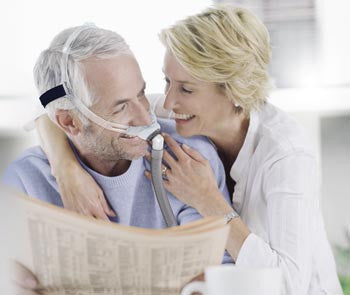How do you know what type of CPAP mask would best fit your needs while treating your obstructive sleep apnea? At My CPAP Club, we offer two types of masks for CPAP therapy, including:
 Using the right mask is essential to the success of your treatment. You need a mask that is comfortable and fits properly. It should form a good seal on your face so that air doesn't leak (this would be uncomfortable and make your therapy less effective). A nasal mask that covers the nose is the most common choice among individuals suffering from obstructive sleep apnea.
Using the right mask is essential to the success of your treatment. You need a mask that is comfortable and fits properly. It should form a good seal on your face so that air doesn't leak (this would be uncomfortable and make your therapy less effective). A nasal mask that covers the nose is the most common choice among individuals suffering from obstructive sleep apnea.
However, some people breathe through their mouth when they sleep. In this case, a full face mask that covers both the nose and mouth is the best option. Another option would be a nasal mask and chinstrap, which will prevent the jaw from opening during sleep and still provide you with effective CPAP therapy.
If you are still unsure of what CPAP mask is the right option for you, contact My CPAP Club today at 1-888-272-7050. We would be happy to explain our different mask types and answer any questions you may have.
One of the most common questions customers ask us is, “What exactly is CPAP therapy?” CPAP stands for “continuous positive airway pressure,” and it is considered to be the most recommended and effective treatment for obstructive sleep apnea (OSA). There are two parts to CPAP therapy:
 The air pressure is determined during your sleep study, and your doctor will prescribe you a CPAP machine at that pressure. CPAP therapy is traditionally provided through a nasal mask or full-face mask that seals around the nose. However, more innovative and comfortable options are available, and advances in the delivery of CPAP therapy are continually occurring.
For instance, CPAPs with FLEX or EPS technology offer you exhalation relief. APAP, BiPAP and Bi-Level machines offer various levels of pressure throughout the night and exhalation relief.
The air pressure is determined during your sleep study, and your doctor will prescribe you a CPAP machine at that pressure. CPAP therapy is traditionally provided through a nasal mask or full-face mask that seals around the nose. However, more innovative and comfortable options are available, and advances in the delivery of CPAP therapy are continually occurring.
For instance, CPAPs with FLEX or EPS technology offer you exhalation relief. APAP, BiPAP and Bi-Level machines offer various levels of pressure throughout the night and exhalation relief.
Humidification plays a big role in CPAP therapy in that it adds humidity, or moisture, to the CPAP air. This reduces nasal passage irritation and even bleeding caused by dryness. Also, adding moisture reduces possible swelling, excess mucus, congestion and sneezing, and makes patients’ sinuses less susceptible to bacterial infections.
If you are tired of living with obstructive sleep apnea, reach out to the CPAP experts at My CPAP Club by calling 1-888-272-7050. We would be happy to give you more information about CPAP therapy and how it can change your life for the better.